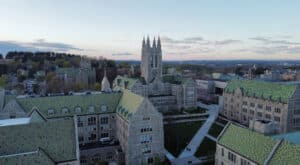When the Supreme Court overturned affirmative action in 2023, University President Rev. William P. Leahy, S.J., issued a rare statement, condemning the ruling and reaffirming Boston College’s commitment to enrolling talented students from diverse racial backgrounds.
The University also released the racial demographic makeup of the Class of 2028 in Sept. 2024—a key move to increase transparency and start a conversation about the effects of this ruling at BC.
Despite increases in Hispanic and Asian student enrollment, the percentage of Black students in the first-year class fell from 7 percent to 6—a 14 percent year-over-year decrease in the number of Black freshmen at BC. This is the start of what may be a concerning enrollment trend on the Heights in years to come.
This year, however, BC has not released the racial demographics for its newest class.
Although BC disclosed the percentage of AHANA+ students in the Class of 2029, it should also release a specific racial demographic breakdown to hold itself accountable and provide necessary information to prospective AHANA+ students.
Leahy’s 2023 statement emphasized the need for BC to uphold its Jesuit values while abiding by the new legal boundaries governing race in admissions.
“The University intends to remain faithful to its Jesuit, Catholic intellectual and religious heritage by enrolling talented, diverse students from across the United States and the world within the new parameters set by the court.” the statement said.
It also reaffirmed that the University would remain in the Questbridge program and other community-based scholarship organizations, maintain need-blind admissions, and enroll its first class of students at Messina College—a two-year program aimed at providing a pathway to higher education for 100 low-income students every year.
Since then, BC has fulfilled all of these major promises—that’s admirable.
Still, understanding the racial makeup of newly enrolled classes is crucial for prospective students and the future of this university.
Each letter in the AHANA+ acronym possesses its own individual characteristics, culture, and identities. By breaking the data down further, prospective students can better assess how represented they might be in the student body, instead of a generalized label that lumps together many distinct identities.
Difficult as it may be, BC proved it could comb through these metrics when it released the data last year. While the Class of 2029 is not the first to be affected by the banning of affirmative action, the data is no less valuable.
It’s true that the University had not published this data before the ruling. Instead, it releases the BC Fact Book every spring. This guide offers an ethnic breakdown of the entire undergraduate population, not separated by class, buried somewhere within its 83 pages.
But this information is not easily accessible to prospective students.
Google “BC racial data,” and the Fact Book is nowhere to be found. What does come up, rather, is a Common Data set with information about the Class of 2027—enrolled before the ban was implemented.
Other universities—including our neighbors at Harvard and MIT—have led by example and made this information public.
This data is not any less useful when you cross over from Cambridge to Chestnut Hill. Prospective AHANA+ students have the right to consider this information when deciding whether or not BC will be a good fit for them.
Enrolling full-time in college is a long, expensive commitment. BC should offer students all the resources they need to make a well-reasoned decision. The University’s reluctance to provide that information hinders its transparency and does not make good on its words from two years ago.
BC made an unusually strong commitment to continue promoting diversity on campus in the absence of affirmative action. If it wants to deliver on that commitment, it must release the racial demographic data for the Class of 2029 and subsequent classes.


